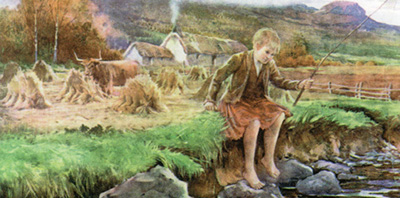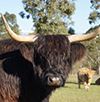Highland Cattle..
The World’s Most Iconic Cattle


Good Looks!
Easy Calving!
Docile Cattle!
Scottish Highland Cattle
Highland Cattle have been in Scotland since at least the sixth century and are as Scottish as kilts and whisky!
Located in Victoria, Australia, we founded Cruachan Highland Cattle in 1987 and have been at the forefront of breeding these wonderful animals for 38 years.
Famous for their looks there are surely no cattle as cute and cuddly as the Scottish Highland Cattle breed, but there’s a lot more to these “shaggy, hairy, beasties” than just a pretty face.
Browse through the wealth of information below, including the advantages of the breed for the small property holder, as well as the origins of the cattle and their history.
Check out our Highland Cattle for Sale page. Then have fun viewing photos of some of our herd along with cute calves, before going on to read the many articles that we have gathered over the years about these beautiful cattle.

Highland Cattle Advantages
Grazing the rugged Scottish landscape since the sixth century, Highland Cattle have many fine attributes.
Docile, easy to handle, hardy, easy calving, and ideal for the smaller property.

Highland Cattle for Sale
We have retired and downsized from mainsteam breeding, but from time to time we will have a very limited amount of animals for sale.
Check out our Sales Page for our thoughts on animals to suit your needs.

Our Farm
Located in Victoria and founded in 1987, we have been breeding these wonderful animals for 38 years.
We spent 10 years on the show circuit in the 90's with many wins locally and interstate.

Carcass Traits
Highland Cattle beef is increasingly being recognized in Australia for it's marbling attributes.
Marbling is closely associated with the key meat qualities of tenderness, juiciness and flavour.

Historical Articles
Older articles which have been reprinted many times over the years.
It includes an excerpt from the Highland Cattle Society Herd Book, Scotland, Volume 1, published in 1885.

Feature Articles
Includes one man's Childhood Memories of Highland Cattle in the early 1950's.
Also, two different author's take on the history of Highland Cattle, plus an experiment run by the Manyberries Range Station, Canada.

PHOTO'S
Cruachan Highland Cattle invite you to look at a selection of photos. Its not all hard work, we have had a lot of fun over the years with these fluffy cattle.

General Info
Articles on Evaluation of Cattle Traits, Embryo Transfer in Cattle, Frame Scoring, and an article describing "Crop Ear" in Highland Cattle

Links
Links to Highland Cattle websites, both in Australia and overseas, plus links to international databases to help trace the pedigrees of your Highland Cattle.
Most Read Articles
A small selection of the articles that have been shown to be most popular.

The History of Highland Cattle
Highland Cattle are an old breed known to have grazed the rugged Scottish landscape since the sixth century. It is still a matter of debate as to whether they were an origin of Scotland or imported from Scandinavia perhaps with the Vikings when they invaded Great Britain.
Read more...

20 of the Most Frequently Asked Questions about Highland Cattle
We have been breeding these beautiful cattle for 38 years, and have put together a list of common questions, as well correcting some common myths.
Read more...

Pure Highland Beef is Healthy!
Scientific tests carried out on Pure Highland Beef by the Scottish Agricultural College demonstrate convincing evidence that Highland Beef is significantly lower in Fat and Cholesterol, and higher in Protein and Iron than other beef.
Grass fed cattle have a healthier ratio of omega-6 to omega-3 fatty acids.
Read more...

Fullblood, Graded, or What?
Australia and New Zealand are the only two countries in the world to allow registration of Highland Cattle that have been graded-up from another breed of cattle. It creates a lot of discussion.
Read more...

Long Haired Highlanders
"Highland cattle have certainly retained some primitive traits absent from other domesticated breeds."
"The bulls keep a close watch over their herds, guiding them carefully through danger, across rain swollen rivers, or over marshy ground..."
Read more...

Canadian 'Manyberries' Experiment
Of interest to every farmer should be the results of experiments run by the CDA at the Manyberries Range Experimental Station, involving herds of purebred Highland cows, Highland-Hereford Cross cows, and purebred Hereford cows.
Read more...

Yon Bonnie Canny Kine
"To most people, the Highlander is a long horned, shaggy coated, ferocious wild animal that can be dug out of a glacier after several years immersion".
Published in 1980, the famous "Harrowsmith" article by Donalda Badone, Ontario, had a huge impact and doubled the number of Canadian Highland breeders within 12 months.
Read more...

Frame Scoring Highland Cattle
Breeding livestock cannot be selected on one factor alone. The use of height measurement and frame scores can be an aid to the selection and production of a growthier type of Highland Cattle.
Read more...

Embryo transfer in cattle.
This is an article written by my son Ross in 1992 as a school project. It seems to be a very popular article for students worldwide who are studying this topic, and covers the process from start to finish. The article gains more "views" than many other pages on our website.
Read more...

Monarch of the But 'n Ben
"They are as Scottish as kilts and whisky. These shaggy, hairy cattle have been in Scotland for thousands of years. For centuries the source of both pleasure and conflict, they were at one time the backbone of the Highland economy. They are Highland Cattle..."
Read more...

Crop Ear in Highland Cattle
Crop ear can best be described as a cosmetic defect found in Highland Cattle. It can be as little as a very slight notch in the ears through to severe “cropping”.
It is a contentious issue that creates discussion world wide. Highland Cattle Breed Societies differ in their approach to Crop Ear.
Read more...

Our Herd favourites
We have put together a selection of the cattle that formed the basis of Cruachan Highland Cattle, and this is their story. None of them are alive today but their genetics live on within the current Cruachan herd.